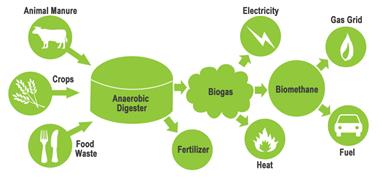Description

Disclaimer: Copyright infringement not intended.
Context
- Recently, Asia's largest Compressed Bio Gas plant inaugurated in Sangrur, Punjab by Union Minister.
Compressed Biogas
- Biogas is an environmentally-friendly, renewable energy source. It's produced when organic matter, such as food or animal waste (agriculture residue, cattle dung, sugarcane press mud, municipal solid waste, sewage treatment plant waste, etc) is broken down by microorganisms in the absence of oxygen, in a process called anaerobic digestion.
- Then the Bio-Gas is purified to remove hydrogen sulphide (H2S), carbon dioxide (CO2), water vapour and compressed as Compressed Bio-Gas (CBG), which has methane (CH4) content of more than 90%.
- CBG has calorific value and other properties similar to CNG and hence can be utilized as green renewable automotive fuel. Thus, it can replace CNG in automotive, industrial and commercial areas, given the abundance of biomass availability within the country.
- The potential for Compressed Bio-Gas production from various sources in India is estimated at about 62 million tonnes per annum.

Benefits of CBG
There are multiple benefits from converting agricultural residue, cattle dung and municipal solid waste into CBG on a commercial scale:
- Responsible waste management, reduction in carbon emissions and pollution
- Additional revenue source for farmers
- Boost to entrepreneurship, rural economy and employment
- Support to national commitments in achieving climate change goals
- Reduction in import of natural gas and crude oil
- Buffer against crude oil/gas price fluctuations
CBG Plant at Sangrur, Punjab
- The CBG Plant at Sangrur, is spread across an area of 20 acres (approx.). The plant's present production is about 6 TPD CBG, but soon this plant will process 300 Tons Per Day of paddy straw at max. capacity to produce 33 TPD of CBG using 8 digesters of 10,000 cubic meters.
Benefits of this plant at Sangrur
- This plant will consume 100,000 tons of paddy straw, which will be procured from 6-8 satellite locations within a 10 km radius of the plant. There shall be daily production of about 600-650 Tons of FOM (Fermented Organic Manure), which can be used for organic farming. The CBG Plant shall also provide direct employment to 390 and indirect employment to 585 people.
- It will also provide a much-needed alternative to stubble burning. The CBG Plant will reduce stubble burning of 40,000 – 45,000 acres of fields, translating into an annual reduction of 150,000 tons of CO2 emissions. This will not only ensure that the citizens of Sangrur, Punjab, breathe in cleaner air but also contribute towards India's COP26 Climate Change targets of total projected carbon emissions by one billion tonnes from now to 2030 Achieving the target of net zero emissions by 2070.
- The Compressed Bio Gas (CBG) plant in Sangrur is a step in achieving objectives of the Sustainable Alternative Towards Affordable Transportation (SATAT) scheme.
Final Thought
- CBG plants are a huge leap forward in arriving at a win-win situation for farmers and the environment.
|
SATAT SCHEME
Sustainable Alternative Towards Affordable Transportation (SATAT) is an initiative aimed at setting up of Compressed Bio-Gas production plants and make CBG available in the market for use as a green fuel. The Scheme targets entrepreneurs to set up Compressed BioGas plants and later sell this fuel so obtained to Oil Marketing Companies as automotive or industrial fuel.
The initiative was launched in 2018 by the Ministry of Petroleum & Natural Gas.
There are 4 clear-cut objectives of the SATAT scheme. They are as follows -
Decreasing dependence on import of fuel.
Making use of more than 62 million metric tonnes of waste generated each year in India.
Boosting job creation in the country.
Reducing vehicular emissions and harmful emissions from the burning of agricultural waste.
|
Read: https://www.iasgyan.in/daily-current-affairs/biogas
https://pib.gov.in/PressReleasePage.aspx?PRID=1868887














